Jan 08
NYC Marathon 2014
Jan 02
Fried artichokes and zucchini, with beer batter.
Ingredients
24 oz or 790 ml of peanut oil
6 baby artichokes
2 zucchini
For the batter
2 egg whites
2 dl of beer
120 gr flour
A pinch of salt
A teaspoon of evoo
Cut the zucchini in half length wise, and then again in half across. Then slice lengthwise, and discard the center part with the seeds, keeping the green side. to make small zucchini sticks.
Clean the artichokes, discard the dark green per leaves, discard the tip, and the outer part of the base. Cut each artichoke heart in four and keep it in cold water with lemon juice to keep them from darkening.
For the batter
Mix flour and beer with a whisk, add the oil and let it rest for 30 minutes at room temperature. Mount the egg whites, and add to the batter. Add the salt.
Deep fry
Heat the peanut oil in a deep pan, about 10 inches in diameter, on a high flame. When the oil is hot, pat dry the vegetables, put them in the batter 15 pieces at a time., and one by one on the hot oil. Do not fry too many pieces at once otherwise the temperature of the oil will decrease.
Put each batch of fried vegetables on a plate covered with kitchen paper, to absorb any excess oil, and add salt.
Important
Eat immediately!
Dec 18
Brined Pork Loin Roast with Pomegranate Sauce
For Thanksgiving I wanted to prepare a pork roast with pomegranate. I tried this excellent recipe with a few changes. It was a real delicacy, definitely a “must try again”. Here is my version of the recipe.
For the brine
2 cups plus 1.5 L cold water, divided
1/3 cup coarse salt
1/4 cup sugar
8 black peppercorns
8 juniper berries, crushed*
2 star anise
2 bay leaves
1/4 teaspoon yellow (or black) mustard seeds
1 (2-lb.) boneless pork loin roast, rolled, tied
For the roast
3 garlic cloves
fresh rosemary or oregano
olive oil
For the Pomegranate Sauce
1 large pomegranate or 2 small (or 1 cup 100% pomegranate juice)
2 Tbsp Cognac (or grappa)
1 teaspoon cornstarch
1 teaspoon balsamic vinegar
Prepare the brine. Bring 2 cups of the water, and all the ingredients for the brine, to a boil in large pot over medium-high heat, stirring to dissolve salt and sugar. Remove from heat; add the remaining 1.5 liters of water. Let it cool, stirring occasionally. Place the pork in the brine. (Pork should be completely covered by liquid.) Cover and refrigerate 12 to 24 hours.
Prepare the roast. Remove pork from brine; blot dry with paper towels. Discard brine. Clean the garlic cloves and cut them in 3 or 4 pieces lengthwise. Clean the rosemary and pat dry. With a small paring knife, pierce a few holes in the roast, about 1 inch deep. In each hole insert one piece of garlic and a few rosemary leaves.
Heat oven to 400°F. Heat oil in large skillet over medium heat until hot. If you are using a layered stainless steal pan you may not need the oil. Cook pork 8 minutes or until browned on all sides. Start by placing the roast fat side down in the skillet. Place on rack in roasting pan. Discard oil from skillet; reserve skillet for sauce (do not clean).
Bake pork 45 to 55 minutes or until internal temperature reaches 145°F. Cover loosely with foil; let stand 20 minutes.
Slice and serve with the pomegranate sauce.
Prepare the pomegranate sauce. Clean the pomegranate and obtain the juice pressing the pomegranate seeds with a vegetable mill; add a bit of water. Preserve a few of the seeds whole, for decoration.
Add pomegranate juice to reserved skillet, stir in the cognac, and bring to a boil.
If you are using 100% juice, boil over medium heat until reduced to 1/2 cup.
Whisk 4 teaspoons of cold water and cornstarch in small bowl; whisk into sauce to blend. Cook until sauce thickens. Remove from heat; stir in vinegar and accumulated roasting juices.
Nov 24
Almond and orange cake, without flour.
This cake is always a big success. Any time I have made it, I have been asked for the recipe. What a better reason for posting it? The ingredients are a bit of a surprise, there is no flour, and no butter or oil, just almonds, sugar, eggs, and whole oranges. Yes, with the whole skin! I recommend it, it is truly delicious.
Ingredients (in parenthesis are the quantities for a smaller cake)
- 2 (1) organic oranges (boiled for 30 minutes and blended)
- 280g (190g) of blanched almonds
- 240g (160g) of sugar
- 1 Tsp of baking soda (or baking poder)
- 1 Tsp of vanilla extract (or bitter almonds)
- 1 Tbsp of Cointreau (or rum)
- 6 (4) eggs lightly beaten
- Confectionery sugar to garnish
- Candied orange peals, toasted sliced almonds, or dark chocolate to garnish.
Put the whole oranges in a large pot and cover them with cold water. Bring to a boil and cook for 30 minutes.
While the oranges are boiling, blend the almonds with one third of the sugar until they become a fine powder. To add the sugar is essential, because it absorbs the almond oil avoiding that they become like a paste as you blend them.
When the oranges are cooked, cut them in four parts and let them cool. Preheat the oven to 360F. Discard the seeds from the oranges (navel oranges a seedless), and blend them with all the skin. If the orange rind at the top and the bottom is too thick I take those parts off.
In a bowl mix the blended oranges, the blended almonds, the rest of the sugar, the baking powder, the vanilla extract, and the liquor.
Finally lightly beat the eggs and add them to the rest of the ingredients.
Cover a cake baking dish (10 inches in diameter) with wet parchment paper, and pour in it the cake mixture.
Bake for 50 minutes.
Garnish with confectionery sugar. If you like you can also add some candied orange peals, toasted sliced almonds, or dark chocolate to garnish.
I made this cake with the reduced quantities in parenthesis, and the result was a round cake of 10 inches in diameter and 1 inch thick.
Nov 15
Roasted delicata squash with thyme and parmesan
Ingredients
2 delicata squash
Fresh thyme
Olive oil
Salt and pepper
Parmesan cheese
Preheat the oven at 400F (convection, roasting).
Wash the squash, cut them in half longitudinally, and take off the seeds with a spoon. Do not peel them. Then slice into slices no more than half inch thick.
In a large bowl, dress the squash with salt, fresh thyme leaves, pepper, and extra virgin olive oil.
Cover a baking sheet with parchment paper, and lay the squash in one layer.
Roast for 20 minutes, or until the edges start to brown.
Take the delicata out of the oven, transfer them on a serving dish, and sprinkle a generous amount of grated parmesan cheese.
Enjoy!
.
Nov 13
Skate and Romanesco soup
When I saw this beautiful broccolo Romanesco at the market, I knew I would use it to make this traditional soup from Rome.
The result was delicious, and perfect for the cold weather we are having in New York.
Ingredients
1lb of skate fish
1 broccolo romanesco
1 carrot
1 small onion
Half celery stalk
1 garlic clove
Parsley
One anchovy
One Roma tomato, peeled and chopped
Olive oil
Salt and pepper
Cover the skate with cold water, and boil for half an hour to make a clear and flavorful fish broth.
Finely chop the onion, the celery, the carrot, the garlic, and the parsley (stem included) to make a soffritto. Put the prepared vegetables in a casserole, add some extra virgin olive oil, and cook for a few minutes. Chop the anchovy in small pieces and add it to the soffritto. Then peal and chop the tomato, and add it to the soffritto, to give some color to the soup.
Separate the broccolo into small heads, add it to the casserole and let the flavors blend. Add salt and start adding the skate broth one ladle at a time. Let cook about 15 minutes, continuing to add the broth, to make a dense soup.
Adjust salt and pepper, as needed. Add half of the fish meat.
Break the spaghetti in three parts and cook them in the soup, they will need ten minutes.
Oct 27
Marinated Striped Bass
Ingredients
1lb striped bass filet
For the marinade:
- juice of half a lemon
- lemon rind, grated
- olive oil
- parsley
- thyme
- rosemary, finely chopped
- 1 garlic clove, finely minced
- salt
Mix all the ingredients for the marinade in a glass bowl. Add the fish, cover with a lid or clear wrap, and let marinade in the fridge for 3 hours.
Preheat the oven to 400F.
On the stove heat well a pan that can then go in the oven. I use an enameled cast iron pan.
When the pan is hot, add the fish skin down and cook for 4 minutes. Add some white wine and transfer in the oven. Bake for about 8 or 10 minutes.
Jan 24
Seville Orange Marmalade


I do not usually make jam but I love bitter orange marmalade and is not easy to find a good one. I was in Fareway about ten days ago and found Seville oranges, I could not resist and decided to make marmalade.
I browsed the web for recipes and found two I liked. One is from
Simply Recipes and the other is David Labovitz’s recipe. The recipe from Simple Recipes has a much higher percentage of fruit and should result in a much more intense fruit flavor, the recipe from David Labivitz is is reviewed as a more classic recipe for Seville orange marmalade.
I decided to go for a more intensely flavored marmalade with higher fruit content but not too much and increased a bit the amount of sugar and water
Ingredients (for about 8 small jars)
- 1.3 Kg of Seville oranges (in my case 14 small oranges)
- 6 cups of water
- 6 cups of sugar
1) Juice – Wash the oranges, cut them in half and juice them.
2) Save seeds and membranes – As you juice the oranges save the seeds in one glass. With the help of a spoon scrape all the membranes, and some of the white part, from the juiced half rinds. Save the membranes in a bowl.
3) Scrape and cut the rind – Take each half rind, with a paring knife cut it in half and scape some more of the white part. Then slice it in this strips with a chef knife.
4) Bag membranes and seeds – Put the seeds and membranes into 4 layers of cheesecloth, tied up tightly with string, or into a muslin jelly bag (I used bag hand made by me for the membranes and a spice bag for the seeds). Membranes and seeds contain the pectin necessary to solidify the marmalade.
I ended up with:
- 1 and 3/4 cups of juice
- 300 gr of rinds
- bags with membranes and seeds
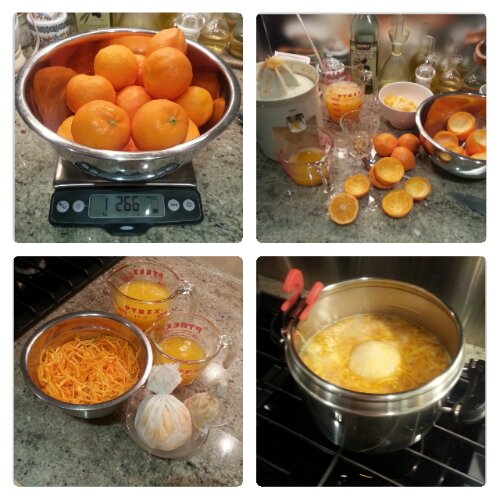
5) Cooking 1st part –
Put the orange juice, the rinds, and the membranes and seeds bags in a pot.
Add the water.
As the mixture cooks, the pectin from the seeds and membranes will be extracted into the mixture.
Bring to a boil and boil for about 30 minutes or until the rinds are soft.
Then remove the pot from the heat, take out the bags with membranes and seeds and let them cool down on a plate.
6) Measure cooked mixture, and add sugar and pectin –
Measure the cooked fruit and add the same amount of sugar.
I got 6 cups of cooked oranges, and added 6 cups of sugar.
Squeeze the bags of seeds and membranes to extract 2 to 4 Tbsp of pectin, and add the pectin to the fruit mixture.
7) Cooking 2nd part –
Heat the fruit mixture on medium and boil, stir occasionally and cook for about 30 minutes or so to set. The cooking time may vary, therefore you will need to check it frequently.
If you have a candy thermometer, attach it to the side of the pot. When the mixture reaches a temperature of 220°F the marmalade is ready.
To check if the marmalade is ready you can also do the following. Keep a few small plates in the freezer. Put a bit of marmalade on a chilled plate to check if it is runny and thin keep cooking, if it holds its shape and has a jelly consistency it is ready.
8) Sterilize the jars
Put the jars in a large pot with water, and boil for 10 minutes. I use a pasta pot with the insert, so that the jars don’t touch the bottom of the pot.
Put the jar lids in a bowl and pour hot water on them.
Let the jars dry and cool down.
9) Canning
Pour the marmalade in the jars, leaving 1/4 inch of space on the top.
Close the jars and wait for them to “pop” as the vacuum seal is created.
Dec 10
Ravioli with spinach and ricotta
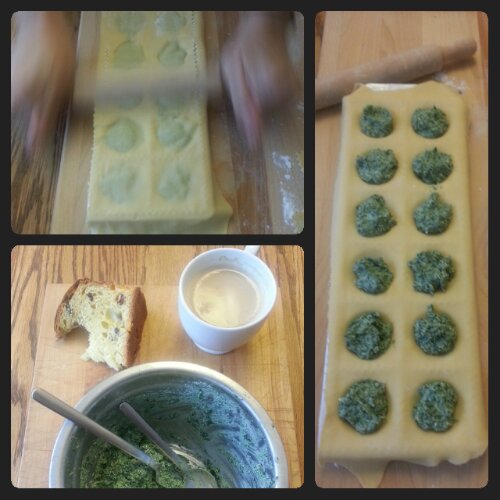
Every now and then I like to make pasta fatta in casa (home made pasta). Yesterday I prepared some ravioli di magro, the classic ravioli filled with spinach and ricotta. A rainy Sunday morning is the ideal time to make some ravioli. And… yes while working at these ravioli I was having a cappuccino with Panettone!
If you make some extra you can freeze them and you can cook them, in boiling water, when they are still frozen (you do not have to thaw them before boiling them). With these ingredients I made 42 ravioli.
Ingredients for the dough
- 160 gr all purpose flour
- 40 gr hard durham flour (semola di grano duro)
- 2 eggs
Ingredients for the filling
- 150 gr of steamed spinach (1 bag) well drained and squeezed
- 200 gr ricotta
- 50 gr parmigiano finely grated
- a pinch of grated nutmeg
Prepare the dough
Mix the flour with the eggs and knead the dough until it becomes very smooth. Wrap the dough in cleat wrap and let it rest in the fridge while you prepare the filling.
Prepare the filling
Steam the spinach and let them cool down. Squeeze them very well to take away as much liquid as possible. Finely chop the spinach with a chef knife. In a bawl, mix the spinach with the ricotta and the grated parmesan cheese.
Make the ravioli
Using a pasta machine, flatten the dough to the smallest thickness. You will need to do this gradually, in four or 5 steps, starting from the larger thickness (number 1) all the way to the smaller one (number 8, on my machine).
Fill the ravioli as you flatten the dough otherwise the dough will dry and will not stick well when you close the ravioli.
Freeze the ravioli, if you like.
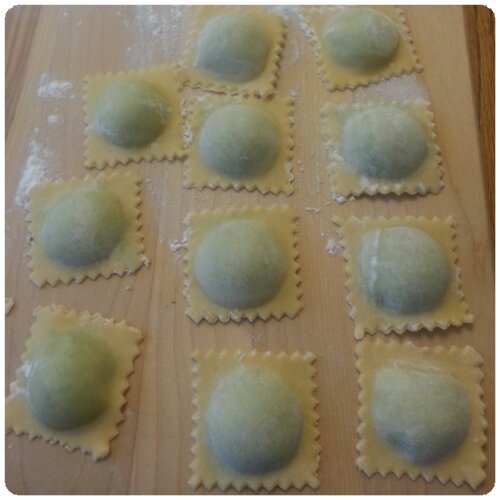






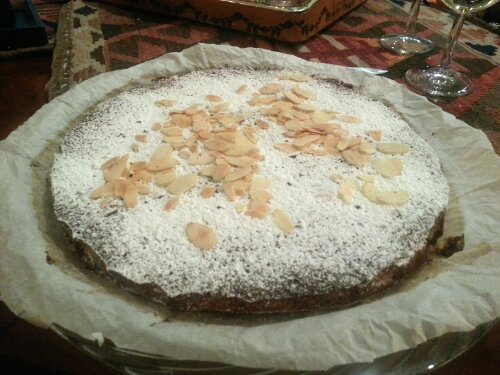
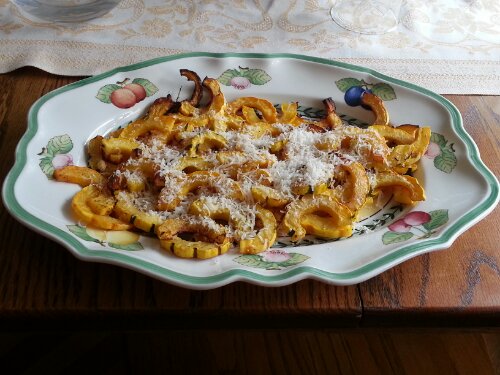
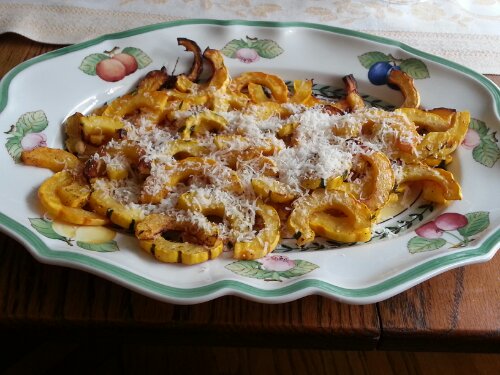
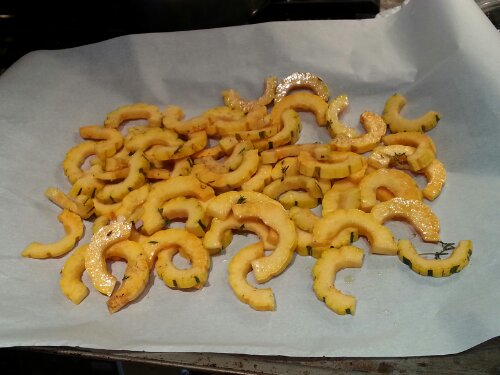

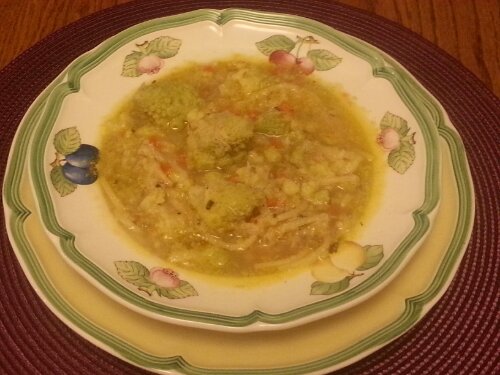
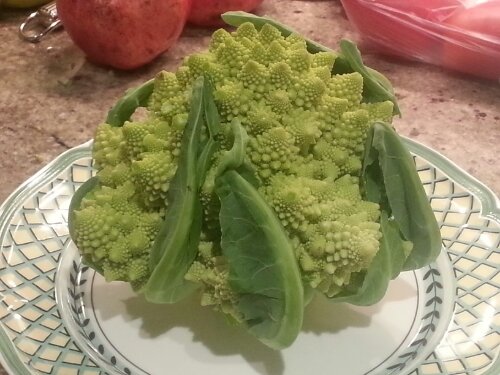
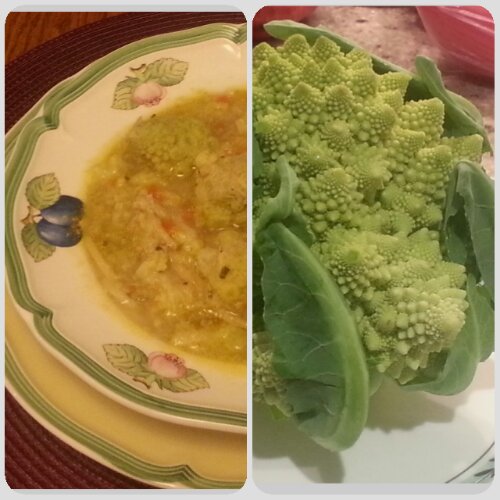
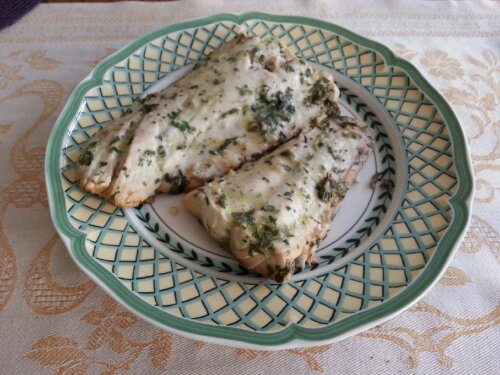
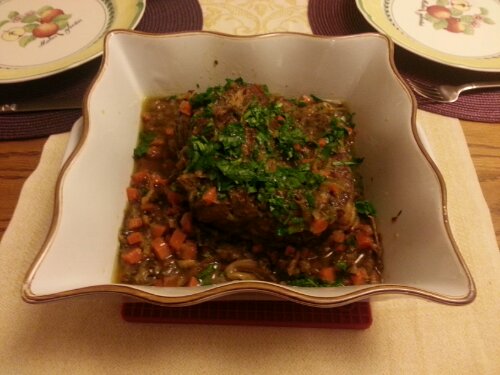
Recent comments